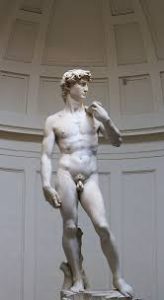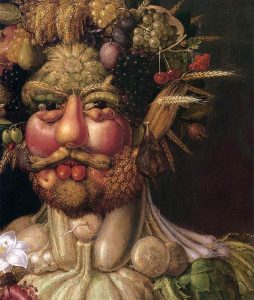Omnia Era of Cider | Pommes in Art
Omni is defined as being a bit of everything. With that definition in place it is fair to say that Cider is in the Era of Omnia.
Let’s search for the fruit of the story from the Renaissance era to the often-bizarre works of the Mannerist painter and sculptors of that time. We are exploring how history is repeating itself in our cups of cider in this edition of Pommes in Art.
Take for instance, Michelangelo’s sculpture of David.

Work began in 1501 and was finished 1504.
David stands at 517 cm high × 199 wide cm, which is 17 ft high × 6.5 ft wide. Just imagine the size of that white marble before the task of sculpting began. They had to put up staging to work around the marble block and one simple misstep… and years of work could be gone.
Michelangelo’s David is classified as “art of the Renaissance era”.
I had no idea at the time what that meant. But now know, thanks to my research for Pommes in Art, that this period is all about of symmetry. The Renaissance depicted the idealized human and scene.
If I knew then what I know now, maybe I would have lingered a bit longer before that marble statue before bolting for the door.
Cider like art can overwhelm and turn off the would-be drinkers.
Like art with its Early Renaissance, Renaissance and Late Renaissance, cider also has its periods of time.
- Early Cider
- PreProhibition Cider
- Post Prohibition Cider
- and the period that we are currently in which I call” Omnia”, which is Latin for Everything.
In the Omnia Era of Cider everything is up for grabs from traditional cidermaking to modern. The consumers want variety and the makers are meeting their patron’s demand.
As a cider geek, I have some understanding of cider through the ages and enjoy delving into a glass and looking for the subtleties.
For the rest of the drinking world I can only imagine how quickly they might get bored by cider,
“Where are the bubbles?” Or “I can’t taste the apple?”
When life is not relatable, we move on. “I don’t get this painting.” can be flipped just as easily to
“I don’t get this cider.”
What is relatable is a good story and both art and cider are gold medal winners in this arena.
In this episode 217, I thought all I was going to talk about was one portrait of Rudolf II who was the Holy Roman Emperor from 1576–1612. The Italian painter Giuseppe Arcimboldo used fruits, meats, fish, vegetables and assorted objects to create the portrait. Using assorted edibles and objects was Arcimboldo’s trademark. He did a series of portraits depicting the four seasons, Winter, Spring, Summer and Autumn. And another series on the four elements, Earth, Air, Fire and Water. But his most famous of all is of Rudolf II.


Knowing Rudolf II title, I was a little concern for Arcimboldo. Was the Holy Emperor of Rome amused or angered by this fruity depiction?
Evidently, he was amused and was quite the connoisseur of the unusual. It wasn’t unusual for Rudolf II to be found gazing at his art collection. The guy could deal with out of the box. I bet he would have liked a cider made with habanero pepper from the Omnia Era of Cider.
Arcomboldo’s portrait of Rudolf II wasn’t just a typical portrait like one would see in the Renaissance period. He depicted the Holy Emperor of Rome as Vertumnus, the Roman god of metamorphoses. It was a brilliant move by Arcimboldo to portray his patron as a god. Like who wouldn’t want that? Right?
Vertumnus is of particular interest to us student of all things Pomme because he was considered a shape shifter who at one time took the shape of an old woman, in his quest to win over the goddess Pomona. In case you do not know of Pomona she is the Roman goddess of fruit trees, gardens, and orchards providing this apple goddess a unique status within mythology because unlike other Roman goddesses and gods, she does not have a Greek counterpart.
Pomona comes the Latin word “pomum” meaning orchard fruit.
The tale of Pomona and Vertumnus is told in the 14th book of Roman poet Ovid’s Metamorphoses. There is a total of 15 books telling the story of over 250 myths. Even by today’s standard, where we think the Harry Potter series of 7 books is something. Imagine Ovid doing so without a great pen to write with or a computer for that matter. Yow!
Back to the story of Vertumnus. He had tried to seduce Pomona a number of times before using his super powers of shapeshifting. He tried being an apple picker, harvester, keeper of a vineyard, a fisherman and a soldier. Pomona didn’t want men in her orchards, because she didn’t want them to trample the gardens. So, each time she turned away the shape shifting god. It wasn’t until he transformed into an old woman that Pomona allowed him to enter.
Once next to Pomona and still in disguise of an old women, he began to tell tales of unrequited love that ended miserably for the suitor. Pomona was not swayed, that is until Vertumnus finally took off his disguise and showed his true self. Pomona falls for the dude and they live happily ever after tending the gardens together.

Which just goes to show you that the moral of Ovid’s story of Vertumnus and Pomona is that deception will not prevail over one’s own true authentic self.
This lesson is a true to today as it was then back in a.d. 8 when Ovid wrote his poem Metamorphoses! And in case you are wondering how long ago that is, well the computer calculations say over 2000 years ago. And in case you are wondering if cider was around back then, the answer would be yes. The folks on the western coast of Spain where writing about cider way back then too!
I believe this Omnia Era of Cider is quite similar to the Mannerist period where anything goes.
Like the Mannerist period we see today a bit of chaos, imbalance, and even shock and awe in ciders during this Omnia era.
- Who will be the Arcimboldo of Cider that the future will salute in the years to come?
- How long will this Omnia Era of Cider last?
As I figure now, this period of cidermaking is less than 20 years old which if we look to art as our guide is a relatively short time.
Transformation is inevitable, and more often than not it is uncomfortable.
This spring of 2020 is one of those moments of time worldwide when transformation is here whether we like it or not.
2020 will be told in stories and noted by generations to come.
We are living the history of tomorrow.
We are creating our narrative and we will transform.
Haven’t downloaded this episode yet? Here it is.



